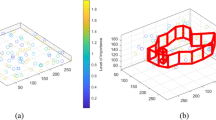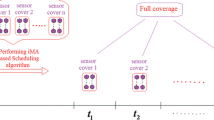Abstract
In wireless sensor networks (WSNs), energy efficient wakeup scheduling of sensor nodes is one of an efficient approach for saving the energy consumption of the network. Determining an optimal wakeup schedule of sensor nodes with satisfactory coverage and connectivity requirements is very challenging issue and known as NP-hard problem. In literature, several evolutionary or meta-heuristic algorithm-based schemes are proposed for solving this problem. Most of the existing wakeup scheduling schemes consider only either coverage or connectivity constraint. Only very few proposed schemes consider both coverage and connectivity constraints for determining an optimal wakeup schedule. These existing schemes do not guarantee optimal solution and sometimes struck in local minima. In this paper, an improved Memetic Algorithm based energy efficient wakeup scheduling scheme is proposed where four constraints are considered such as energy consumption, coverage, connectivity, and optimal length of wakeup schedule list. The proposed scheme devises a novel mutation, crossover, and local search operators. An extensive simulation experiments are done in different network scenarios to prove the performance of the proposed scheme and compare its performance with two latest existing schemes. The results confirm that the proposed scheme performs better than the existing schemes in terms of coverage ratio, optimal number of active sensor nodes and network lifetime.









Similar content being viewed by others
References
Rault, T., Bouabdallah, A., & Challal, Y. (2014). Energy efficiency in wireless sensor networks: A top-down survey. Computer Networks, 67, 104–122.
Yick, J., Mukherjee, B., & Ghosal, D. (2008). Wireless sensor network survey. Computer Networks, 52(12), 2292–2330.
Gupta, G. P., & Jha, S. (2018). Integrated clustering and routing protocol for wireless sensor networks using Cuckoo and Harmony search based metaheuristic techniques. Engineering Applications of Artificial Intelligence, 68, 101–109.
Gupta, G. P. (2018). Improved cuckoo search-based clustering protocol for wireless sensor networks. Procedia Computer Science, 125, 234–240.
Cardei, I., & Cardei, M. (2008). Energy-efficient connected-coverage in wireless sensor networks. International Journal of Sensor Networks, 3(3), 201–210.
Jia, J., Chen, J., Chang, G., & Tan, Z. (2009). Energy efficient coverage control in wireless sensor networks based on multi-objective genetic algorithm. Computers & Mathematics with Applications, 57(11–12), 1756–1766.
Lee, J. W., Choi, B. S., & Lee, J. J. (2011). Energy-efficient coverage of wireless sensor networks using ant colony optimization with three types of pheromones. IEEE Transactions on Industrial Informatics, 7(3), 419–427.
Liu, X., & He, D. (2014). Ant colony optimization with greedy migration mechanism for node deployment in wireless sensor networks. Journal of Network and Computer Applications, 39, 310–318.
Yang, C., & Chin, K. W. (2013). Novel algorithms for complete targets coverage in energy harvesting wireless sensor networks. IEEE Communications Letters, 18(1), 118–121.
Byun, H., & Yu, J. (2014). Cellular-automaton-based node scheduling control for wireless sensor networks. IEEE Transactions on Vehicular Technology, 63(8), 3892–3899.
Rebai, M., Snoussi, H., Hnaien, F., & Khoukhi, L. (2015). Sensor deployment optimization methods to achieve both coverage and connectivity in wireless sensor networks. Computers & Operations Research, 59, 11–21.
Gupta, S. K., Kuila, P., & Jana, P. K. (2016). Genetic algorithm for k-connected relay node placement in wireless sensor networks. In Proceedings of the second international conference on computer and communication technologies (pp. 721–729). Springer.
Adulyasas, A., Sun, Z., & Wang, N. (2015). Connected coverage optimization for sensor scheduling in wireless sensor networks. IEEE Sensors Journal, 15(7), 3877–3892.
Gupta, S. K., Kuila, P., & Jana, P. K. (2016). Genetic algorithm approach for k-coverage and m-connected node placement in target based wireless sensor networks. Computers & Electrical Engineering, 56, 544–556.
Chen, H., Li, X., & Zhao, F. (2016). A reinforcement learning-based sleep scheduling algorithm for desired area coverage in solar-powered wireless sensor networks. IEEE Sensors Journal, 16(8), 2763–2774.
Yang, C., & Chin, K. W. (2016). On nodes placement in energy harvesting wireless sensor networks for coverage and connectivity. IEEE Transactions on Industrial Informatics, 13(1), 27–36.
Deif, D. S., & Gadallah, Y. (2017). An ant colony optimization approach for the deployment of reliable wireless sensor networks. IEEE Access, 5, 10744–10756.
Wang, Y., Wu, S., Chen, Z., Gao, X., & Chen, G. (2017). Coverage problem with uncertain properties in wireless sensor networks: A survey. Computer Networks, 123, 200–232.
Movassagh, M., & Aghdasi, H. S. (2017). Game theory-based node scheduling as a distributed solution for coverage control in wireless sensor networks. Engineering Applications of Artificial Intelligence, 65, 137–146.
Binh, H. T. T., Hanh, N. T., & Dey, N. (2018). Improved cuckoo search and chaotic flower pollination optimization algorithm for maximizing area coverage in wireless sensor networks. Neural Computing and Applications, 30(7), 2305–2317.
Xu, Y., Ding, O., Qu, R., & Li, K. (2018). Hybrid multi-objective evolutionary algorithms based on decomposition for wireless sensor network coverage optimization. Applied Soft Computing, 68, 268–282.
Panag, T. S., & Dhillon, J. S. (2018). A novel random transition based PSO algorithm to maximize the lifetime of wireless sensor networks. Wireless Personal Communications, 98(2), 2261–2290.
Gupta, G. P., & Jha, S. (2019). Biogeography-based optimization scheme for solving the coverage and connected node placement problem for wireless sensor networks. Wireless Networks, 25(6), 3167–3177.
Harizan, S., & Kuila, P. (2019). Coverage and connectivity aware energy efficient scheduling in target based wireless sensor networks: An improved genetic algorithm-based approach. Wireless Networks, 25(4), 1995–2011.
Carrabs, F., Cerulli, R., D’Ambrosio, C., & Raiconi, A. (2017). Exact and heuristic approaches for the maximum lifetime problem in sensor networks with coverage and connectivity constraints. RAIRO-Operations Research, 51(3), 607–625.
Lersteau, C., Rossi, A., & Sevaux, M. (2018). Minimum energy target tracking with coverage guarantees in wireless sensor networks. European Journal of Operational Research, 265(3), 882–894.
Heinzelman, W. B., Chandrakasan, A. P., & Balakrishnan, H. (2002). An application-specific protocol architecture for wireless microsensor networks. IEEE Transactions on Wireless Communications, 1(4), 660–670.
Moscato, P. (1989). On evolution, search, optimization, genetic algorithms and martial arts: Towards memetic algorithms. Caltech Concurrent Computation Program, C3P Report, 826, 1989.
Sen, S., Narasimhan, S., & Deb, K. (1998). Sensor network design of linear processes using genetic algorithms. Computers & Chemical Engineering, 22(3), 385–390.
Deb, K., Pratap, A., Agarwal, S., & Meyarivan, T. A. M. T. (2002). A fast and elitist multiobjective genetic algorithm: NSGA-II. IEEE Transactions on Evolutionary Computation, 6(2), 182–197.
Gupta, G. P., Misra, M., & Garg, K. (2017). Towards scalable and load-balanced mobile agents-based data aggregation for wireless sensor networks. Computers & Electrical Engineering, 64, 262–276.
Gupta, G. P., & Saha, B. (2020). Load balanced clustering scheme using hybrid metaheuristic technique for mobile sink based wireless sensor networks. Journal of Ambient Intelligence and Humanized Computing, 1–12.
Acknowledgements
This work is supported by the SEED Research Grant Project (NITRR/Seed Grant/2016-17/21), National Institute of Technology, Raipur, India.
Author information
Authors and Affiliations
Corresponding author
Additional information
Publisher's Note
Springer Nature remains neutral with regard to jurisdictional claims in published maps and institutional affiliations.
Rights and permissions
About this article
Cite this article
Chawra, V.K., Gupta, G.P. Memetic Algorithm based Energy Efficient Wake-up Scheduling Scheme for Maximizing the Network Lifetime, Coverage and Connectivity in Three-Dimensional Wireless Sensor Networks. Wireless Pers Commun 123, 1507–1522 (2022). https://doi.org/10.1007/s11277-021-09197-2
Accepted:
Published:
Issue Date:
DOI: https://doi.org/10.1007/s11277-021-09197-2




